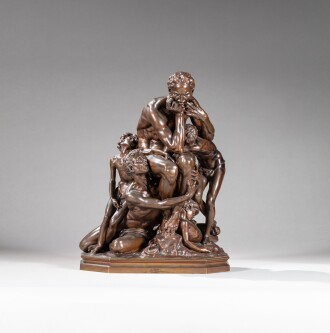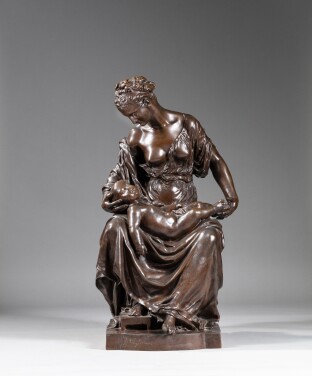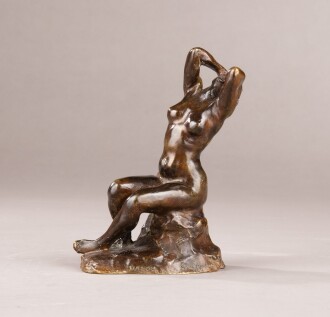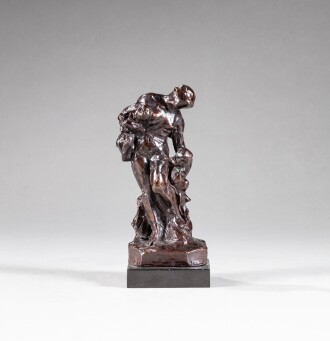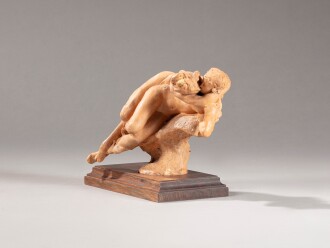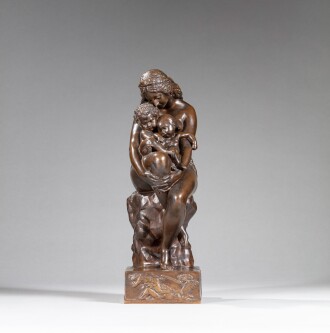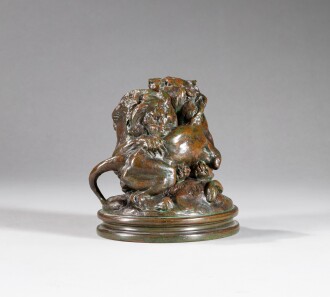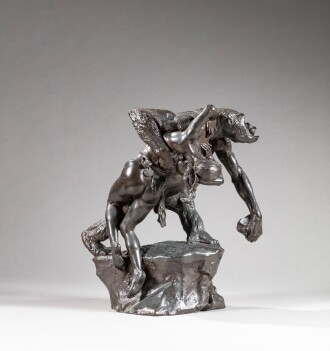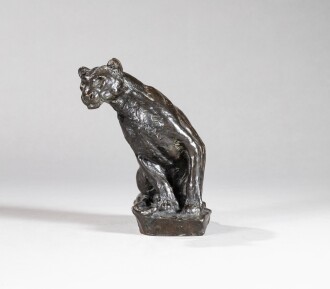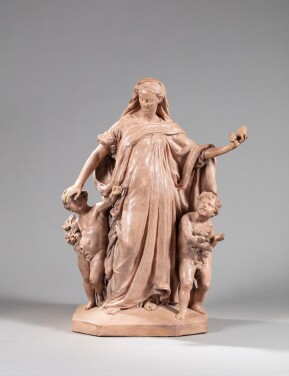I n the spring of 1990, a landmark exhibition entitled “Sculpture Passion” took place in the Art Deco “Salle des Arts” of the Sporting d’Hiver in Monaco under the high Patronage of S.A.S. Princess Caroline of Monaco during the Printemps des Arts.
This exhibition of a hitherto relatively unknown private collection of bronzes and plasters belonging to a Monegasque couple, Jacques and Michèle Ginépro of works by the great sculptors of the 19th and early 20th century attracted much attention and admiration for its diversity, depth of subject matter and the museum quality of the pieces shown.

All the great sculptors of the mid to late 19th century such as: Antoine-Louis Barye, Joseph Bernard, Emile Antoine Bourdelle, , Jean Baptiste Carpeaux, Albert Ernest Carrier-Belleuse, Jules Dalou, Paul Dubois, Emmanuel Frémiet, Jules Mène, Auguste Rodin and Francois Rude and many others were represented in the collection. The subject matter ranging from studies for great public monuments of the day such as “la Danse” commissioned to adorn the great Opera house designed by Garnier to mythological subjects, the allegorical, the biblical, portraiture, the domestic interior, many concentrating on the female figure and the animalier were all present in this fascinating and wide ranging collection.
Indeed after the 1990 exhibition the very quality of the works, their subject matter and sculptors featured, concentrated mainly within the boundaries of the mid to end of the 19th century attracted generations of collectors, enthusiasts, curators, and young specialists from auction houses to beat a path to the Ginépro’s door. Here there was always a warm welcome by these passionate collectors to discuss, to admire, to learn, to document and to exchange knowledge.
It was in 1951 that the young Jacques Ginépro acquired two works at the Puces de Saint Ouen “Arlequin” by Mercier and “Genie de la Danse” by Carpeaux. These acquisitions were the beginning of a lifelong interest and the genesis of a collection emblematic of the very best of the sculptural arts as practiced during the dynamic, politically explosive and culturally revolutionary France of the 19th century.
We see the overthrow of Napoleon Ist, the Restoration of the Monarchy, the July Monarchy, the Revolution of 1848, the later establishment of the Second Empire and that of the Troisième Republic after the Commune of 1871.
These Regime changes acted as catalysts in the Arts, leading to a change of subject matter and differing aesthetic. The styles and preoccupations of a previous century; the Rococo, neo classicism and the Empire were deemed of the past.
Industrialization and the new techniques in casting bronzes were significant in bringing the art of sculpture in differing sizes and editions to a wider and more diverse public of collectors. Thus, increasing demand and creating a dynamic marketplace.
The July Monarchy’s policy of building public monuments, and later under Napoleon III the ambitious reconstruction of Paris was a rich terrain for commissions for the new public buildings glorifying the attainments of an industrialized era. This and the growing wealth of the new middle classes created an ever-increasing demand for works to furnish their new homes and to acquire decorative arts from the sculptors and artists of the day.
The various Regime changes throughout the 19th century encouraged the Arts and artists. The programmes encouraging the very best in the Arts set up by previous governments stayed in place. For example, many young artists and sculptors such as Carpeaux studied abroad at the Villa Medicis in Rome, imbibing the culture of the Renaissance and their Greek and Roman forebears. An example of a work created there being the great sculpture “Ugolin” inspired by the work of Michelangelo and the Laocoon which is but one work to come from this rich vein.
Interestingly the plethora of public sculpture commissions, also meant that many artists could also concentrate on a more domestic aesthetic. A sculptor might work on a state commission as well as those nearer to home. One thinks of Dalou and the charm of the home interior; “La Liseuse”, or “La Brodeuse”, and the marvelous and heart-rending series of bronzes of everyday working life come to mind.
Lest one forget the purely decorative was not forgotten during this period; nymphs, young fishermen, portraits and busts of pretty girls, odes to the sweet life, animalier subjects were also in vogue. Many of the bronzes in the Ginépro collection are indeed a testament to this.
The Ginépro collection is rich in every subject matter as we have noted , here the collector will find something for all whether it be academic, decorative , small or large, bronze or plaster, the collection exemplifies the diversity, the skill, the quality of workmanship and the technical brilliance of the artists and the foundries of the period. Above all the depth of connoisseurship and commitment to the bronze and the sculptors of the 19th century is paramount in this marvelous collection. It is of note that Jacques and Michèle Ginépro were precursor’s in this field as much of the collection was formed at a time when there was not as much interest or knowledge in the subject as today.
Sadly, Jacques Ginépro is no longer with us, his charming smile, warm welcome and eagerness to share his knowledge now of the past. His family have decided that it is now time to let others enjoy this wonderful collection much cherished over a period of nearly sixty years. We are honoured that they have chosen Sotheby’s to help these pieces find new homes.
Read LessAuction Highlights

Originally from Valenciennes, Jean-Baptiste Carpeaux was a pupil of François Rude (1784 – 1855) and Francisque Duret (1804 – 1864). In 1854, he was awarded first prize in the Prix de Rome for his sculpture Hector and Astyanax. His relief of The Emperor receiving Abd-el-Kader at Saint-Cloud came to the attention of Napoleon III, resulting in a commission from the State that same year.
From 1856 to 1859, as a pensionnaire at the Villa Medici in Rome, Carpeaux produced his Young Fisherman with a Shell (1859) and Ugolino – his final envoi – (1860–1861), which brought him fame.
Thanks to his friendship with the architect Charles Garnier, when he returned to Paris Carpeaux was asked to contribute to the decoration of the newly built Opéra’s facade with his celebrated group Dance (1869). When the Pavillon de Flore was being rebuilt between 1863 and 1866, the architect Hector Lefuel entrusted Carpeaux with the decoration of the south façade, overlooking the Seine. Lefuel’s requirements were both aesthetic and political: the monumental group Imperial France protecting Agriculture and Science was to decorate the pediment, while The Triumph of Flora, a more daring composition, would grace the attic exterior. One of Carpeaux’s masterpieces is the Fontaine de l’Observatoire, commissioned in 1867 by the Paris authorities: this remarkable representation of the Four Parts of the World was exhibited at the Exposition Universelle in 1889.
Carpeaux was appointed court portraitist and in 1865 the Empress Eugénie commissioned him to make a full-length portrait of her son: The Prince Imperial Louis-Napoleon with his dog Nero. He also carved busts of Princess Mathilde (1862), Napoleon III and his wife Eugénie, the writer Alexandre Dumas (1873), the architect Charles Garnier (1869), and the painter and sculptor Jean-Léon Gérôme (1871).
Carpeaux excelled in the narrative treatment of his compositions, which he executed with virtuosity in terracotta and marble before producing editions in bronze. He drew his subjects first, before modelling them in clay. Whether in pencil or clay, his sketches are wonderful illustrations of the various stages of his thought, as he worked towards the final model.
The Goncourt Brothers praised his work in their Journal of 24 May 1894:
'… at the exhibition of Carpeaux – Oh the admirable busts of Gérôme, of Giraud, of Maître Beauvois, that Vitellius of the legal fraternity. No, apart from the those by the Greeks, I know of no comparable busts: yes, these busts are superior to those of Houdon, whose facture is after all a little dry and pinched; yes, these busts show that no sculptor has succeeded like him in conveying the fullness of living flesh in marble, bronze or terracotta. And his busts of women are executed with strength and power – something sculptors never achieve who are only concerned with prettiness – despite their delicate construction, elegant line and sweet facial features expressing, so to speak, the material spirituality of the female being (…).'










